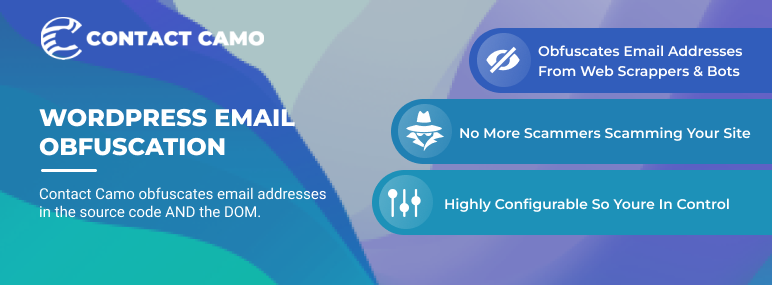ContactCamo Wordpress Plugin - Rating, Reviews, Demo & Download

Plugin Description
The ContactCamo plugin totally obfuscates email addresses from web scrapers and bots to help prevent spam.
What is it?
ContactCamo is a plugin for WordPress developed by Plan Left that totally obfuscates email addresses from web scrapers and bots to minimize spam and other nefarious, automated actors.
In addition to effective obfuscation of email addresses, ContactCamo also provides some granular control over how those obfuscated email addresses can be displayed and interacted with by users that are very useful to site builders and also help make site maintenance easier.
Why did you make this plugin?
We have a client that is a well-known brand with a WordPress site that regularly experiences high traffic volumes. Due to the public visibility of our client and their large user base, their web properties are under constant threat from spammers and bots. Our client requested that we ensure their user directories were safe from these threats while still being functional to visitors. In other words, we needed to hide a bunch of email addresses from the outside world while still allowing the outside world to contact those users via their email address. When we got into developing this plugin for our client, we knew we had to provide them a solution that was as bulletproof as possible while allowing them the most amount of control over things as practical.
Ultimately, we needed to create a plugin that would:
* Obfuscate email addresses from scrapers and bots securely and confidently. For our use case, email addresses needed to be obfuscated in the source code, the DOM, and in HTTP requests. We took the email address out of the client-side equation completely by just tucking it safely away in the database in a lookup table instead of providing a workaround that simply disguises the email address. We essentially took the email address to a safe house and sent out its representative to interact with the outside world on its behalf. Nobody gets the email, not no way, not no how, see?!?
* Provide users with lots of control over the UX of obfuscated email addresses, but without the need for cumbersome configuration. We decided a shortcode with some good options and sensible defaults would foot the bill for most users.
* Be performant in capabilities, lightweight in footprint, and opinionated in scope.
* The client was very pleased with the end-result and so were we. So, we decided to offer it back to the community. Our development team reviewed and scrutinized the existing plugin, found areas for improvements and further customizations, and baked them right in for everyone to use.
Who is it for?
Site administrators and content editors/moderators. Anyone with a WordPress site that would like the peace of mind of knowing that their user’s email addresses are safely hidden from spam bots and other unintended consumers with ill intent. Content creators that don’t want to worry about the complications and time expenditure of dealing with and managing their user base getting spammed from their platform. And especially when any of the above mentioned require some level of control over what’s displayed to their users, who may very well be their customers or clients or patients, etc…It’s for site builders that want protection AND customization without being overwhelmed.
What problems does it solve?
ContactCamo obfuscates email addresses in the source code AND the DOM. Not only this, it ensures the unobfuscated email address is never used in any page or ajax request from its originating context; all handling/processing is done server-side. Once obfuscated, the client-side never sees the original email address again (where obfuscated). The obfuscation (key) is a hash that is stored in a lookup table with the original email address.
A few of the limitations we found in some existing (but great) plugins:
* email address only obfuscated in DOM, but not in source code
* email address only obfuscated in source code, but not in the DOM
* integrating with a 3rd-party service that scrapes entire pages and performs a search-and-replace of email addresses with obfuscated versions in the source code
* email address obfuscation using only html entities replacement
* few options for controlling output
* no contact form or fallback options
How does it work?
ContactCamo simply provides a shortcode that can be used to manually obfuscate email addresses and control how the obfuscated email address is presented back to the end-user. The shortcode accepts parameters for CSS classes and an optional text label, so the sky’s the limit for display.
The shortcode’s eventual output is a clickable link with the obfuscated email address’s generated hash stored in a data attribute. On click, this hash is used to lookup the email address (or generate and store a new hash for that email if one doesn’t already exist) and then open the browser’s configured email client with the “To” field pre-populated with the corresponding email address.
The shortcode also accepts a parameter that tells it to output a clickable link that displays a modal contact form on click instead of opening the browser’s default email client. This contact form can be configured for captcha integration.
The plugin maintains a lookup table of any obfuscated emails in your WordPress site’s database.
A paid version of the plugin is planned that will allow not only bulk adding of email addresses to obfuscate without the need for always using the shortcode (great for staff directories and contact listings), but also provides the ability to obfuscate email addresses that match any given URL wildcard pattern.
The paid version also has plans to integrate with existing, popular contact form solutions such as Ninja Forms and Contact Form Plus.
What can I do with it?
We chose to err on the side of simplicity, balanced with enough options as to be useful. To this, we default to an anchor tag output, or – if overridden – a clickable button. We give the user control over which of these as well as css classes and an id. The text output is configurable. And with one option, you can have a modal contact form popup when users click on your link. All without showing the email address you want to use, but hide. Hide for real for real. The plugin includes template files if you wish to really change the output, like maybe you want a different wrapper, or need to include some custom data attributes for javascript to use. We thought about adding all that level of configuration to our shortcode, but figured if you were at that point, you’d probably also know how to edit a template file 😉
Here’s some ways you can use it:
[contactcamo email=”contact@example.com”]
output:
[contactcamo email=”contact@example.com” label=”Contact Us” form=true button=true]
output:
[contactcamo email=”contact@example.com” subject=”ContactCamo” class=”mail-icon-lg mail-link”]
output:
[contactcamo email=”contact@example.com” id=”one-contactcamo-to-rule-them-all” label=”Fly, You Fools!” button=true class=”btn btn-lg btn-lt-blue mail-icon-sm”]
output: <large, light blue clickable button with text that says “Fly, You Fools!” along with an inline mail icon>
Shortcode Parameters
email required string
the email address to be obfuscated
label optional string default=”Email”
the text output
subject optional string
the text to populate mail subject lines
class optional string
the css class(es) to add to the anchor/button html output, space delimited
id optional string
the css id to add to the anchor/button html output
form optional boolean default=false
if true, output contact form in place of link
popup optional boolean default=false
if true, output link that opens modal contact form on click
button optional boolean default=false
if true, output link as a clickable button instead of an anchor tag
There is also an admin page for ContactCamo. From this page, you can configure where the contact form redirects after form submission.
Screenshots
No screenshots provided




